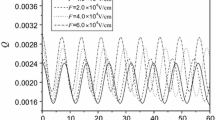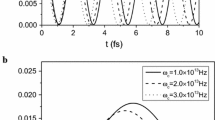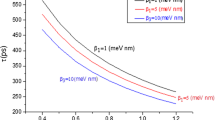Abstract
We academically explore the properties of the coherence time (CT) of an electron powerful coupled to the phonons in a RbCl quantum pseudodot (QPD) qubit with an exterior electric field alongside the ρx direction. By employing the Pekar type variational method (PTVM) and the Fermi golden rule, the CT changes with the electric field, the chemical potential of the two-dimensional electron gas (CPTDEG), the zero point of the pseudoharmonic potential (ZPPHP) and the polaron radius is studied. The examined results indicate ① that the CT of RbCl QPD qubit decays with aggrandizing electric field, ② that the CT is a decreasing function of the CPTDEG, the ZPPHP and the polaron radius, ③ that here we can find that we can adjust the CT by changing the external electric field, the CPTDEG, the ZPPHP and the polaron radius.
Similar content being viewed by others
Avoid common mistakes on your manuscript.
1 Introduction
With the development of the quantum information communication in the low-dimensional nanomaterial, crisis-conscious physicists focus on the study of quantum information processing. The executions of quantum computation depends on not only the implementations of the theoretical framework in computation systems, but also the measurements of the experiment phenomena of quantum information [1]. The smallest construction of information content of a message can be measured in terms of the qubits [2]. The two-level system is usually employed as qubit for transmitting information. It is demonstrated that quantum computer with considerable qubits would be realized in solids [3], especially by invoking semiconductor quantum dot (QD).
Recently, there has been many academic and tentative works on the quantum computer. Moreover, the investigations about quantum coherence properties of the QD qubit have become the main research subjects. For example, Abadillo-Uriel et al. [4] reported the signatures of atomic-scale structure in the energy dispersion and coherence of a Si quantum-dot qubit. Delteil et al. [5] demonstrated realization of a cascaded quantum system: Heralded absorption of a single photon qubit by a single-electron charged QD. Koski et al. [6] experimentally investigated the floquet spectroscopy of a strongly driven QD charge qubit with a microwave resonator. Meanwhile, many theoretical investigators present that the methods of various QD materials are efficient to realizing the transmission of qubits in the quantum information science. Such as parabolic potential, triangular potential, Gaussian potential and so on.
In the recent years, the researchers found that a new confinement potential called pseudoharmonic potential (PHP) is closer to the actual potential of QD. Furthermore, the qubit was built by two-level energy in the special QPD. For example, Khordad and Ghanbari [7] employed the effect of phonons on optical properties of RbCl QPD qubits. Liang and Xiao [8] studied the effect of electric field on RbCl QPD qubit. Chen and Xiao [9] investigated the effect of temperature and electric field on a QPD qubit and the electron’s probability density and the oscillating period of an electron in a three-dimensional RbCl QPD. However,the electric field effect on the CT of qubit in the QPD hasn’t studied yet.
In this article, the intention of the authors is to dig into the properties of the CT of an electron strongly coupled to phonon in a RbCl QPD qubit with an external electric field. There are three parts in the main body of the article. In the part 2 of this article, the Hamiltonian of the electron and phonon interaction system in QPD with the extra electric field is given. The ground- and first- excited-states (GFES) of the system will be calculated by following the PTVM. Then the superposition state and the CT are investigated by using the Fermi golden rule [10]. Part 3 shows the numerical results and discussion of the relation between the CT and electric field and the QPD’s parameters. Finally, in the conclusion, the results indicate that the electric field, the QPD’s parameters are important factors to investigate of the CT of the RbCl QPD qubit.
2 Theoretical Model
Considering an electron confined in a RbCl QPD crystal with PHP interacting with the bulk phonons. In the presence of an exterior electric field F along the ρx direction. The Hamiltonian of the electron-phonon interaction system is in the following form [11].
where
where the significances of the physical quantities in Eqs. (1 and 2) are the same with Ref. [11].
And V(r) is the PHP which includes both harmonic QD potential and antidot potential. Besides, V0 is the CPTDEG and r0 is the ZPPHP. We carry out the following Lee-Low-Pines [12] transformation to (1)
where \( {f}_q\left({f}_q^{\ast}\right) \) is the variational function.
According to the PTVM [13,14,15,16], the GFES wavefunctions of the system may be given as
where λ0 and λ1 are the variational parameters. Then the energies of GFES can be calculated and written as follows:
where \( {R}_0={\left(\mathrm{\hslash}/2m{\omega}_{LO}\right)}^{\raisebox{1ex}{$1$}\!\left/ \!\raisebox{-1ex}{$2$}\right.} \)is the polaron radius. In this two-level quantum system a single qubit can be realized. The superposition state have the following forms:
Under the dipole approximation, based on the Fermi golden rule [10], the spontaneous emission rate can be calculated using [17].
where ΔE = E1 − E0 denotes the energy separation between the the GFES and C is the speed of light in vacuum. ε(ε0) is the vacuum dielectric constant and τ is the CT.
3 Numerical Results and Discussion
The effective mass of RbCl, the electron-phonon coupling constant and the energy of bulk phonon are respectively taken as 0.432m0, α = 3.81, and ℏωLO = 21.639meV [18]. The numerical results are exhibited in Figs. 1, 2 and 3.
Figure 1 depicts the CT τ of QPD qubit varying with the electric field F and the CPTDEG V0 for R0 = 1.0nm and r0 = 0.2nm. It is seen from Fig.1 that the CT raises with decaying electric field F. This is because that the CT τ above is dependent not only on the energy separation ΔE between the GFES, but also on the variational parameters λ0 and λ1, besides, the CT τ is a decreasing function of the ΔE. The GFES’ energy levels are decreasing functions of the electric field, and the electric field’s influences on the first-excited state is weaker than that on the ground state. So the ΔE enhances with raising the electric field. So the CT decays. As it can also be seen from Fig.1 that the CT of QPD qubit enhances with decaying CPTDEG. The physical origin is that the energy separation enhances with raising the CPTDEG. So the CT decreases.
The CT τ as the functions of the electric field F and the ZPPHP r0, with R0 = 1.0nm and V0 = 1.0meV is shown in Fig. 2. From Fig. 2, we can clearly see that in the presence of the influence of the ZPPHP r0, whereas without the influences of the CPTDEG V0 and the polaron radiusR0, the CT τ will decrease with increasing electric field F. The results and the reason are in harmony with the Fig. 1 without considerations of the polaron radius and the ZPPHP, whereas only consideration of the CPTDEG. It is also noted that with the decay of the ZPPHP, the CT aggrandize. Because the ZPPHP is weaker in the first-excited state than that in the ground state and the energy separation lifts with raising the ZPPHP. Hence the CT decays.
To make the relationships between the CT τ and the electric field F and the polaron radius R0 more clearly, we have depicted Fig. 3, which presents the CT τ as the function of F and R0 with r0 = 0.1nm and V0 = 1.0meV. It is observed from the Fig. 3 that the CT is an decreasing functions of the polaron radius and the electric field. This is due to the GFES’ energy levels are decreasing functions of the polaron radius, and the polaron radius’ influences on the first-excited state is weaker than that on the ground state. So the ΔE enhances with raising the electric field. So the CT decays with increasing the polaron radius. The reason that the CT will decrease with increasing electric field is similar to the cases of the Fig. 1 without considerations of the polaron radius and the ZPPHP, whereas only consideration of the CPTDEG, and the Fig. 2 without considerations of the polaron radius and the CPTDEG, whereas only consideration of the ZPPHP.
The magnitude of the CT obtained in the present paper is 100–400-1000 ps, which is in agreement with Refs. [19, 20] and [21, 22], which were obtained respectively by experiments and theory. The coherence of qubit is crucial to the investigations of quantum computation, where the CT is one of the physical quantities representing the properties of coherence. Here we can find that we can adjust the CT by changing the electric field, the CPTDEG, the ZPPHP and the polaron radius.
4 Conclusions
In conclusion, we theoretically discuss the effects of the extra electric field, the CPTDEG, the ZPPHP and the polaron radius on the CT of the polaron in a RbCl QPD qubit by using the PTVM and the Fermi golden ruled. The results indicate that the electric field, the CPTDEG, the ZPPHP and the polaron radius are important factors to investigate of the CT of the RbCl QPD qubit.
References
Reed, A.P., Mayer, K.H., Teufel, J.D., Burkhart, L.D., Pfaff, W., Reagor, M., Sletten, L., Ma, X., Schoelkopf, R.J., Knill, E., Lehnert, K.W.: Faithful conversion of propagating quantum information to mechanical motion. Nat. Phys. 13, 1163–1167 (2017)
Chou, K.S., Blumoff, J.Z., Wang, C.S., Reinhold, P.C., Axline, C.J., Gao, Y.Y., Frunzio, L., Devoret, M.H., Jiang, L., Schoelkopf, R.J.: Deterministic teleportation of a quantum gate between two logical qubits. Nature. 561, 368–373 (2018)
Kalb, N., Reiserer, A.A., Humphreys, P.C., Bakermans, J.J.W., Kamerling, S.J., Nickerson, N.H., Benjamin, S.C., Twitchen, D.J., Markham, M., Hanson, R.: Entanglement distillation between solid-state quantum network nodes. Science. 356, 928–932 (2017)
Abadillo-Uriel, J.C., Thorgrimsson, B., Kim, D., Smith, L.W., Simmons, C.B., Ward, D.R., Foote, R.H., Corrigan, J., Savage, D.E., Lagally, M.G., Calderón, M.J., Coppersmith, S.N., Eriksson, M.A., Friesen, M.: Signatures of atomic-scale structure in the energy dispersion and coherence of a Si quantum-dot qubit. Phys. Rev. B. 98, 165438 (2018)
Delteil, A., Sun, Z., Fält, S., Imamoğlu, A.: Realization of a Cascaded Quantum System: Heralded Absorption of a Single Photon Qubit by a Single-Electron Charged Quantum Dot. Phys. Rev. Lett. 118, 177401 (2017)
Koski, J.V., Landig, A.J., Pályi, A., Scarlino, P., Reichl, C., Wegscheider, W., Burkard, G., Wallraff, A., Ensslin, K., Ihn, T.: Floquet Spectroscopy of a Strongly Driven Quantum Dot Charge Qubit with a Microwave Resonator. Phys. Rev. Lett. 121, 043603 (2018)
Khordad, R., Ghanbari, A.: Effect of phonons on optical properties of RbCl quantum pseudodot qubits. Opt. Quant. Electron. 49, 76 (2017)
Liang, Z.H., Xiao, J.L.: Effect of electric field on RbCl quantum pseudodot qubit. Indian J. Phys. 92, 437–440 (2018)
Chen, Y.C., Xiao, J.L.: The Effect of Temperature and Electric Field on a Quantum Pseudodot Qubit. Int. J. Theor. Phys. 57, 533–538 (2018)
Landau, L.D., Lifshitz, E.M.: Quantum mechanics (nonrelativistic theory). London. (1987)
Feng, L.Q., Xiao, J.L.: The effects of temperature and electric field on the properties of the polaron in a RbCl quantum pseudodot. Opt. Quant. Electron. 48, 459 (2016)
Lee, T.D., Low, F.E., Pines, D.: The Motion of Slow Electrons in a Polar Crystal. Phys. Rev. 90, 297–302 (1953)
Pekar, S.I., Deigen, M.F.: Zh. Eksp. Teor. Fiz. 18, 481 (1948)
Pekar, S.I.: Untersuchungen über die Elektronen-theorie der Kristalle. Akademie Verlag, Berlin (1954)
Ding, Z.H., Sun, Y., Xiao, J.L.: Optical phonon effect in an asymmetric quantum dot qubit. Int. J. Quantum. Inf. 10, 1250077 (2012)
Xiao, W., Xiao, J.L.: Coulomb bound potential quantum rod qubit. Superlattice. Microst. 52, 851–860 (2012)
Xiao, J.L.: Effects of temperature and hydrogen-like impurity on the coherence time of RbCl parabolic quantum dot qubit. Superlattice. Microstruct. 90, 308–312 (2016)
Devreese, J.T.: Polarons in ionic crystals and polar semiconductors. North-Holland, Amsterdam (1972)
Hackens, B., Faniel, S., Gustin, C., Wallart, X., Bollaert, S., Cappy, A., Bayot, V.: Phys. Rev. Lett. 94, 146802 (2005)
Hackmann, J., Glasenapp, P., Greilich, A., Bayer, M., Anders, F.B.: Influence of the Nuclear Electric Quadrupolar Interaction on the Coherence Time of Hole and Electron Spins Confined in Semiconductor Quantum Dots. Phys. Rev. Lett. 115, 207401 (2015)
Yuan, X.Z., Zhu, K.D., Li, W.S.: The coherent time evolution of two coupled quantum dots in a two-mode cavity. Eur. Phys. J. D. 31, 499–506 (2004)
Wiersig, J.: Computation of the coherence time of quantum-dot microcavity lasers including photon-carrier and photon-photon correlations. Phys. Status Solidi B. 248, 883–886 (2011)
Acknowledgements
This project was supported by the National Science Foundation of China under Grant No.11464033 & 11464034 and the Inner Mongolia University for Nationalities Research Funded Project (Project No.: NMDYB1756).
Author information
Authors and Affiliations
Corresponding author
Additional information
Publisher’s Note
Springer Nature remains neutral with regard to jurisdictional claims in published maps and institutional affiliations.
Rights and permissions
About this article
Cite this article
Liang, ZH., Cai, CY. & Xiao, JL. The Effects of Electric Field on the Coherence Time of RbCl Quantum Pseudodot Qubit. Int J Theor Phys 58, 2320–2326 (2019). https://doi.org/10.1007/s10773-019-04122-7
Received:
Accepted:
Published:
Issue Date:
DOI: https://doi.org/10.1007/s10773-019-04122-7







